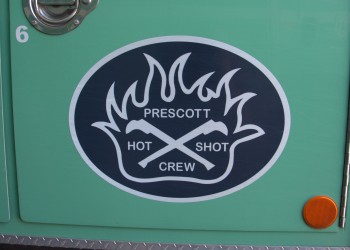Resources
Prescott Fire Center

Located near the Prescott Airport, the Prescott Fire Center and Henry Y. H. Kim Aviation Facility houses an interagency dispatch center, a fire cache, an air tanker base, and fire managers including the Prescott Hotshots and Prescott Helitack. It also serves as a training center and as Incident Command Post for some wildfires in the area.
Prescott Dispatch Center

The Prescott Dispatch Center (PDC) serves multiple federal agencies by mobilizing resources throughout the country in support of wildfire, prescribed fire, law enforcement and other all-risk incidents. PDC provides predictive service products such as fire danger, intelligence, mapping, outlooks and weather. The PDC website has information about training, aerial resources, fire crews, current wildfires and restrictions and more.
Prescott Hotshot Crew

Since 1973 when the crew first received Type I status it has gone through many changes with equipment, technology, and training, however the overall job of a Hotshot has not changed. The Prescott Hotshot Crew still remains as an elite, professional, and outstanding crew of wildland firefighters.
- The Prescott Hotshots originated in 1972 with the formation of a regular crew (Type II). George Pittman was the crew boss with a crew made up of Prescott College students.
- In 1973, Durk Lokes ran the crew and applied for and attained Type I Hotshot Crew status in July of that year.
- In 1975 the crew took on a new look with Mark Zumwalt at the helm. It was at this time that Mark brought with him new technology and crew structure from California and the crew became truly interregional.
- In 1977 the crew was 30 persons strong with three sections of ten each. Sections were rotated and fillers used off the other sections to assure a 20-person crew at all times.
- In 1978, Glenn Dundas took over control and changed the physical standards to what they are today. Glenn ran the crew for seven years and again structural changes were made with the five-person overhead structure one superintendent, two foreman, and two working squad bosses.
- Tom Tobin assumed command in July of 1985. Physical standards remained the same as the integration of a diversified workforce began. That year new crew transportation was purchased which consisted of one chase truck and two nine passenger crew carriers (aka "buggies"). Due to an injury Tom was reassigned to dispatch in 1988.
- Tony Sciacca a seasoned member of the crew took command following Tom’s absence in 1988. In 1991 the crew moved from the Groom Creek Work center to the newly built Prescott Fire Center and Henry Y.H. Kim Aviation Center. Tony’s tour as Superintendent ended after the 1998 fire season and from there he moved on to be a District Fire Management Officer on the Prescott.
- Curtis Heaton who worked his way up through the ranks became Superintendent in 1999 where he remained until the end of the 2001 fire season. Curtis then moved on to the Fish and Wildlife Service as a Wildland Urban Interface Specialist before returning to the Prescott as the Forest Fire Management Officer in 2006. Curtis left the Prescott National Forest in 2008 to serve as the Operations Section Chief on the Phoenix based National Incident Management Organization (NIMO) Team.
- Jeff Andrews who also worked his way up through the ranks became Superintendent in 2002. Jeff is currently the Prescott National Forest Deputy Fire Staff Officer.
- Darin Fisher took over as Superintendent in 2005 and remains in the position today.
Prescott Helitack Crew

Prescott Helitack is a 10-person wildland firefighting helicopter crew based on the Prescott National Forest in Central Arizona. The crew provides initial attack and large fire support to the 1.2-million-acre Prescott National Forest and our neighbors, the Kaibab, Coconino and Tonto National Forests, Phoenix District BLM, and Arizona State Lands.
Prescott Fire Cache

The Prescott Fire Cache (PFK) is a National Incident Support Cache based at the Prescott Fire Center. For incidents within the service area of the Prescott Fire Cache, NFES items are either ordered through dispatch or directly from the cache, depending on the complexity of the incident. PFK stores, manages, and distributes supplies to national incidents and refurbishes durable goods that come back from the field.



